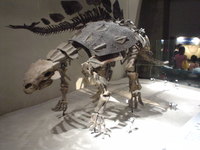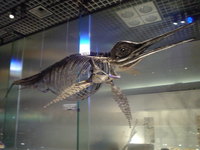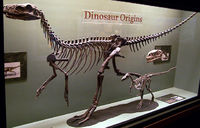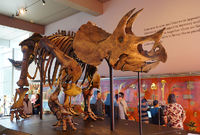2013年02月04日
中生代(9)−三畳紀(1)−三重層序

Triassic flora as depicted in Meyers Konversations-Lexikon (1885〜90)
(旧暦12月24日)
中生代は、三畳紀(Trias)、ジュラ紀(Jurassic)、白亜紀(Cretaceous)の三つの紀からなりますが、約4300万年に及ぶその最初の紀である三畳紀(Trias)という用語は、1834年、ドイツの地質学者フリードリッヒ・アウグスト・フォン・アルベルティ(Friedrich August von Alberti、1795〜1878)が、南ドイツに広く分布する3つの地層をまとめて三畳紀(Trias)と名づけたことによります。
… bunter Sandstein, Muschelkalk und Keuper das Resultat einer Periode, ihre Versteinerungen, um mich der Worte E. de Beaumont’s zu bedeinen, die Thermometer einer geologischen Epoche seyen, … also die bis jezt beobachtete Trennung dieser Gebilde in 3 Formationen nicht angemessen, und es mehr dem Begriffe Formation entsprechend sey, sie zu einer Formation, welche ich vorläufig Trias nennen will, zu verbinden."
…多色砂岩、ムッシェルカルク石灰岩とコイパー泥灰岩は、その時代の結果である。また、それらの化石は、E.デ・ボーモントの言葉を使うと、地質学的時代の温度計であると言える。
これまで保存されてきた層序を3つの層に分離することは適切ではない。そして、今、私が三畳紀と命名する層序に結合する層序の概念とより一致している。

Beitrag zu einer Monographie des bunten Sandsteins, Muschelkalks und Keupers, und die Verbindung dieser Gebilde zu einer Formation.(Stuttgart and Tübingen, J. G. Cotta, 1834)
この3つの層序は、その岩石が建築用の石材および塩や石膏などの化学物質の資源として重要だったため、中世からよく知られた層序でした。
しかしこの分類は、砂漠に蓄積した堆積物起源の局地的な岩石に基づいており、その中に含まれている化石は貝殻石灰岩(Muschelkalk)しかなかったため、世界標準的な層序学には実用的ではありませんでした。
つまりドイツ周辺の海成層は三畳紀中期に属する年代のものに限られるため、三畳紀全体を通しての編年にはオーストリア南部のアルプス山脈、ロシア沿海州南部、中国浙江省長興県煤山、および北アメリカ大陸西部山脈における海生動物の化石に富む地層も併用され、これらを標準として国際的な時期区分が設定されました。
現在では、海棲の進化の早いアンモナイト類動物相に基づいて、三畳紀の詳細な層序が分類されています。
そこで、その3つの地層とは、Wikipediaによれば次のようなものでした。
1. コイパー泥灰岩(Keuper) 上畳統
The Keuper is a lithostratigraphic unit (a sequence of rock strata) in the subsurface of large parts of west and central Europe. The Keuper consists of dolostone, shales or claystones and evaporites that were deposited during the Middle and Late Triassic epochs (about 220 million years ago). The Keuper lies on top of the Muschelkalk and under the predominantly Lower Jurassic Lias or other Early Jurassic strata.
The Keuper together with the Muschelkalk and the Buntsandstein, all 3, form the Germanic Trias Group, a characteristic sequence of rock strata that gave the Triassic its name.

コイパー泥灰岩は、西ヨーロッパおよび中央ヨーロッパの大部分の地表面下にある岩相層序要素(岩石層層序)であり、三畳紀中期および後期(約2億2000万年前)の間に堆積した苦灰岩(ドロマイト、CaMg(CO3)2を主成分とする堆積岩)、頁岩あるいは粘土岩、蒸発残留岩からできている。
またコイパー泥灰岩は、ムッシェルカルク石灰岩(Muschelkalk)の上部、そして主に下部ジュラ紀ライアス統あるいは他の早期ジュラ紀層の下に堆積している。コイパー泥灰岩、ムッシェルカルク石灰岩、ブントザントシュタイン(多色砂岩)の3層は、三畳紀と名付けられた岩層特有の層序であるドイツの三畳紀層を形成している。
The Upper Triassic is well exposed in Swabia, Franconia, Alsace and Lorraine and Luxembourg; it extends from Basel on the east side of the Rhine into Hanover, and through England into Scotland and north-east Ireland; it appears flanking the central plateau of France and in the Pyrenees and Sardinia.
In south Sweden, the lower portion contains coal-bearing strata, as in the Himalayas, Japan, Tibet, Burma, eastern Siberia and in Spitsbergen. The upper portion of the Karoo Supergroup of South Africa and part of the Otapiri stage of New Zealand are probably of Rhaetian age.
後期三畳紀層は、シュヴァーべン(ドイツ南西部)、フランケン地方(ドイツ中南部から南ドイツの北部に位置する地方)、アルザス(フランス北東部)とローレイン(フランス北東部、アルザスの西部)、ルクセンブルクなどでよく露出している。そしてその地層は、ライン川東岸のバーゼルからハノーバーへ、そしてイングランドを通過してスコットランドと北東アイルランドへと延びている。また、フランスの中央台地の側面、そして、ピレネー山脈とサルデーニャにも現れる。
南スウェーデンでは、ヒマラヤ山脈、日本、チベット、ビルマ、東部シベリアとスピッツベルゲンのように、低層部は石炭を産出する層を含む。南アフリカのカルー超層群の上部層とニュージーランドのオタピリ階の一部層は、多分レーティアン期(2億360万年前〜1億9960万年前)の地層であろう。
2. ムッシェルカルク石灰岩(Muschelkalk) 殻灰統
The Muschelkalk (English: shellbearing limestone, French: calcaire coquillier) is a sequence of sedimentary rock strata (a lithostratigraphic unit) in the geology of central and western Europe. It has a Middle Triassic (240 to 230 million years) age and forms the middle part of the Germanic Trias, that further consists of the Buntsandstein (lower part) and Keuper (upper part). The Muschelkalk consists of a sequence of limestone and dolostone beds.
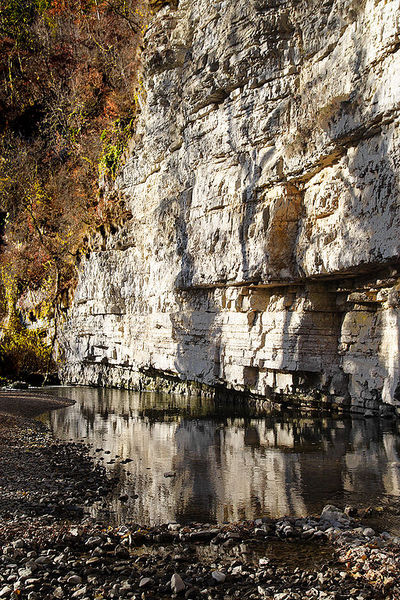
An outcrop of Muschelkalk cliffs forms the shore of the Wutach River, in the south of Baden-Württemberg.
ムッシェルカルク石灰岩(English: shellbearing limestone, French: calcaire coquillier)は、中央ヨーロッパおよび西ヨーロッパの地質学における堆積岩層(岩相層序要素)の層序である。その年代は中期三畳紀(2億4000万年前~2億3000万年前)で、さらに多色砂岩(下部)とコイパー泥灰岩(上部)から成るドイツ三畳紀層の中間部を形成している。ムッシェルカルク石灰岩は、石灰岩と苦灰岩層の層序から構成されている。
In the past the time span in which the Muschelkalk was deposited could also be called Muschelkalk. In modern stratigraphy however, the name only applies to the stratigraphic unit.
過去においては、ムッシェルカルク石灰岩が堆積した期間はムッシェルカルクと呼ぶこともできたが、現代の層位学においては、その名前は層準単位にあてはまるだけである。
The name Muschelkalk was first used by German geologist Georg Christian Füchsel (1722-1773). In 1834, Friedrich August von Alberti included it into the Triassic system. The name indicates a characteristic feature of the unit, namely the frequent occurrence of lenticular banks composed of fossil shells. The Muschelkalk is restricted to the subsurface of Germany and adjacent regions as the low countries, the North Sea and parts of Silesia, Poland and Denmark. Outcrops are found in Thuringia, the Harz, Franconia, Hesse, Swabia, and the Saarland and the Alsace.
ムッシェルカルクという名称は、ドイツの地質学者ゲオルク・クリスチャン・フューゼル(1722〜1773)によって最初に用いられた。1834年、フリードリヒ・アウグスト・フォン・アルベルティは、三畳紀の系統にムッシェルカルク石灰岩を含めた。その名前は、すなわち、貝殻化石から成るレンズ状の堆積層の頻繁な出現といった地層構成の特徴を示している。
ムッシェルカルク石灰岩は、ドイツおよび隣接した地方、北海とシレジアの一部、ポーランドとデンマークといった海抜の低いの地表下の土壌に制限されている。
露頭部は、チューリンゲン州、ハルツ山地、フランケン地方、ヘッセン州、シュヴァーべン(ドイツ南西部)、ザールラント州とアルザス地域圏で見られる。
The Muschelkalk was deposited in a land-locked sea which, in the earlier part of its existence, had only imperfect communications with the more open waters of the Tethys Ocean to the south. The basin in which the Muschelkalk was deposited is called the Germanic Basin.
ムッシェルカルク石灰岩は、その存在の早期の部分では南方のテテュス海のより開放的な海と連絡しない、陸地に囲まれた海に堆積した。ムッシェルカルク石灰岩が堆積した海盆は、ドイツ海盆と呼ばれる。

Germanic basin
Sometimes stratigraphic units with the same age from the Alps, southern Europe and even Asia are called Muschelkalk too. Of course these rocks have little in common with the central European Muschelkalk except for similarities in fossil content. The Alpine Muschelkalk differs in many respects from that of Central Europe, and has a closer affinity with the Triassic Tethys realm.
時々、アルプス山脈、南ヨーロッパとアジアからの同じ年代による層位単位は、ムッシェルカルク石灰岩とも呼ばれている。もちろん、これらの岩石は、化石内容物の類似点を除いて、中部ヨーロッパのムッシェルカルク石灰岩との共通性はほとんどない。
高地ムッシェルカルク石灰岩には多くの点で、中央ヨーロッパのそれと異なって、三畳紀のテテュス領域へのより近い親和性がある。
3. 多色砂岩(Buntsandstein) 斑砂統
The Buntsandstein (German for 'coloured sandstone') or Bunter sandstone is a lithostratigraphic and allostratigraphic unit (a sequence of rock strata) in the subsurface of large parts of west and central Europe. The Buntsandstein predominantly consists of sandstone layers of the Lower Triassic series and is one of three characteristic Triassic units (together with the Muschelkalk and Keuper that form the Germanic Trias Supergroup).
ブントサンドシュタイン(多色砂岩のドイツ語)またはブンタ−砂岩は、西部および中央ヨーロッパの大部分の地表下の土壌の岩相層序および他の層序要素(岩石層層序)である。多色砂岩は、主に底部三畳紀のひと続きの砂岩層から成り、3つの特徴のある三畳紀の単位(ドイツ三畳紀累層群を形成するムッシェルカルク石灰岩、コイパー泥灰岩と共に)のうちの1つである。

Buntsandstein outcrop on Helgoland. The stack is called Lange Anna (German: long Anna).
The Buntsandstein is similar in age, facies and lithology with the Bunter of the British Isles. It is normally lying on top of the Permian Zechstein and below the Muschelkalk. In the past the name Buntsandstein was in Europe also used in a chronostratigraphic sense, as a subdivision of the Triassic system. Among reasons to abandon this use was the discovery that its base lies actually in the latest Permian.
多色砂岩は、イギリス諸島の多色砂岩と年代、年齢、層、岩相の点で類似している。それは、通常、ペルム紀の鉱山統の上部、そして、ムッシェルカルク石灰岩の下に位置している。過去には、ヨーロッパにおいてはブントサンドシュタインという名称が三畳紀の系統の細別として、年代層位の意味で使われた。
この使用を断念する理由は、その基底部が実際に前期三畳紀に位置するという発見であった。
The Buntsandstein was deposited in the Germanic Basin, a large sedimentary basin that was the successor of the smaller Permian Basin and spread across present day Poland, Germany, Denmark, the southern regions of the North Sea and Baltic Sea, the Netherlands and south England. In the late Permian this region had an arid climate and it was covered by inland seas which deposited the Zechstein evaporites. At the end of the Permian a connection with the Paleo-Tethys Ocean to the south was formed in present day southeast Poland, causing sea water to flow in periodically. This caused the inflow of more clastic material, which was deposited in the form of large alluvial fans.
多色砂岩はドイツ海盆に堆積したが、その海盆はより小さなペルム紀の海盆の後継で、現在のポーランド、ドイツ、デンマーク、北海とバルト海の南部地方、オランダ、南イングランドに広がった大きな堆積物の海盆であった。
後期ペルム紀には、この地域は乾燥した気候であり、それは鉱山階蒸発岩を堆積させた内海によって囲まれていた。
二畳紀の終わりに、南方の古代テテュス海との関係は、現在の南東ポーランド形成され、海水が定期的に流入する原因となった。それはより多くの砕屑性物質の流入を生じ、大きな扇状地の形状で堆積させられた。
Deposition took place in an arid, continental environment (playa facies), so that there was little chemical weathering. Therefore the Bundsandstein deposits are typical red beds, mainly sandstones and conglomerates with little clay.
The late Anisian saw a major rise of the global (eustatic) sea level. A tropical sea filled the Germanic Basin then, stopping the deposition of the Bantsandstein and marking the beginning of the deposition of the Muschelkalk.
堆積は乾燥した、大陸環境(プラヤ層、雨期の間水がたまる沈泥平野層)で起きた。そのため、化学的風化がほとんどない。したがって、多色砂岩の堆積は、わずかな粘土を含む典型的な赤色層、主に砂岩と礫岩である。
後期アニス期は、世界的な(海水面変動の)海水面の大きな上昇を見た。熱帯の海はドイツ海盆を満たし、多色砂岩の堆積を止め、ムッシェルカルク石灰岩の堆積の始まりを特色付けた。
The Muschelkalk (English: shellbearing limestone, French: calcaire coquillier) is a sequence of sedimentary rock strata (a lithostratigraphic unit) in the geology of central and western Europe. It has a Middle Triassic (240 to 230 million years) age and forms the middle part of the Germanic Trias, that further consists of the Buntsandstein (lower part) and Keuper (upper part). The Muschelkalk consists of a sequence of limestone and dolostone beds.

An outcrop of Muschelkalk cliffs forms the shore of the Wutach River, in the south of Baden-Württemberg.
ムッシェルカルク石灰岩(English: shellbearing limestone, French: calcaire coquillier)は、中央ヨーロッパおよび西ヨーロッパの地質学における堆積岩層(岩相層序要素)の層序である。その年代は中期三畳紀(2億4000万年前~2億3000万年前)で、さらに多色砂岩(下部)とコイパー泥灰岩(上部)から成るドイツ三畳紀層の中間部を形成している。ムッシェルカルク石灰岩は、石灰岩と苦灰岩層の層序から構成されている。
In the past the time span in which the Muschelkalk was deposited could also be called Muschelkalk. In modern stratigraphy however, the name only applies to the stratigraphic unit.
過去においては、ムッシェルカルク石灰岩が堆積した期間はムッシェルカルクと呼ぶこともできたが、現代の層位学においては、その名前は層準単位にあてはまるだけである。
The name Muschelkalk was first used by German geologist Georg Christian Füchsel (1722-1773). In 1834, Friedrich August von Alberti included it into the Triassic system. The name indicates a characteristic feature of the unit, namely the frequent occurrence of lenticular banks composed of fossil shells. The Muschelkalk is restricted to the subsurface of Germany and adjacent regions as the low countries, the North Sea and parts of Silesia, Poland and Denmark. Outcrops are found in Thuringia, the Harz, Franconia, Hesse, Swabia, and the Saarland and the Alsace.
ムッシェルカルクという名称は、ドイツの地質学者ゲオルク・クリスチャン・フューゼル(1722〜1773)によって最初に用いられた。1834年、フリードリヒ・アウグスト・フォン・アルベルティは、三畳紀の系統にムッシェルカルク石灰岩を含めた。その名前は、すなわち、貝殻化石から成るレンズ状の堆積層の頻繁な出現といった地層構成の特徴を示している。
ムッシェルカルク石灰岩は、ドイツおよび隣接した地方、北海とシレジアの一部、ポーランドとデンマークといった海抜の低いの地表下の土壌に制限されている。
露頭部は、チューリンゲン州、ハルツ山地、フランケン地方、ヘッセン州、シュヴァーべン(ドイツ南西部)、ザールラント州とアルザス地域圏で見られる。
The Muschelkalk was deposited in a land-locked sea which, in the earlier part of its existence, had only imperfect communications with the more open waters of the Tethys Ocean to the south. The basin in which the Muschelkalk was deposited is called the Germanic Basin.
ムッシェルカルク石灰岩は、その存在の早期の部分では南方のテテュス海のより開放的な海と連絡しない、陸地に囲まれた海に堆積した。ムッシェルカルク石灰岩が堆積した海盆は、ドイツ海盆と呼ばれる。

Germanic basin
Sometimes stratigraphic units with the same age from the Alps, southern Europe and even Asia are called Muschelkalk too. Of course these rocks have little in common with the central European Muschelkalk except for similarities in fossil content. The Alpine Muschelkalk differs in many respects from that of Central Europe, and has a closer affinity with the Triassic Tethys realm.
時々、アルプス山脈、南ヨーロッパとアジアからの同じ年代による層位単位は、ムッシェルカルク石灰岩とも呼ばれている。もちろん、これらの岩石は、化石内容物の類似点を除いて、中部ヨーロッパのムッシェルカルク石灰岩との共通性はほとんどない。
高地ムッシェルカルク石灰岩には多くの点で、中央ヨーロッパのそれと異なって、三畳紀のテテュス領域へのより近い親和性がある。
3. 多色砂岩(Buntsandstein) 斑砂統
The Buntsandstein (German for 'coloured sandstone') or Bunter sandstone is a lithostratigraphic and allostratigraphic unit (a sequence of rock strata) in the subsurface of large parts of west and central Europe. The Buntsandstein predominantly consists of sandstone layers of the Lower Triassic series and is one of three characteristic Triassic units (together with the Muschelkalk and Keuper that form the Germanic Trias Supergroup).
ブントサンドシュタイン(多色砂岩のドイツ語)またはブンタ−砂岩は、西部および中央ヨーロッパの大部分の地表下の土壌の岩相層序および他の層序要素(岩石層層序)である。多色砂岩は、主に底部三畳紀のひと続きの砂岩層から成り、3つの特徴のある三畳紀の単位(ドイツ三畳紀累層群を形成するムッシェルカルク石灰岩、コイパー泥灰岩と共に)のうちの1つである。

Buntsandstein outcrop on Helgoland. The stack is called Lange Anna (German: long Anna).
The Buntsandstein is similar in age, facies and lithology with the Bunter of the British Isles. It is normally lying on top of the Permian Zechstein and below the Muschelkalk. In the past the name Buntsandstein was in Europe also used in a chronostratigraphic sense, as a subdivision of the Triassic system. Among reasons to abandon this use was the discovery that its base lies actually in the latest Permian.
多色砂岩は、イギリス諸島の多色砂岩と年代、年齢、層、岩相の点で類似している。それは、通常、ペルム紀の鉱山統の上部、そして、ムッシェルカルク石灰岩の下に位置している。過去には、ヨーロッパにおいてはブントサンドシュタインという名称が三畳紀の系統の細別として、年代層位の意味で使われた。
この使用を断念する理由は、その基底部が実際に前期三畳紀に位置するという発見であった。
The Buntsandstein was deposited in the Germanic Basin, a large sedimentary basin that was the successor of the smaller Permian Basin and spread across present day Poland, Germany, Denmark, the southern regions of the North Sea and Baltic Sea, the Netherlands and south England. In the late Permian this region had an arid climate and it was covered by inland seas which deposited the Zechstein evaporites. At the end of the Permian a connection with the Paleo-Tethys Ocean to the south was formed in present day southeast Poland, causing sea water to flow in periodically. This caused the inflow of more clastic material, which was deposited in the form of large alluvial fans.
多色砂岩はドイツ海盆に堆積したが、その海盆はより小さなペルム紀の海盆の後継で、現在のポーランド、ドイツ、デンマーク、北海とバルト海の南部地方、オランダ、南イングランドに広がった大きな堆積物の海盆であった。
後期ペルム紀には、この地域は乾燥した気候であり、それは鉱山階蒸発岩を堆積させた内海によって囲まれていた。
二畳紀の終わりに、南方の古代テテュス海との関係は、現在の南東ポーランド形成され、海水が定期的に流入する原因となった。それはより多くの砕屑性物質の流入を生じ、大きな扇状地の形状で堆積させられた。
Deposition took place in an arid, continental environment (playa facies), so that there was little chemical weathering. Therefore the Bundsandstein deposits are typical red beds, mainly sandstones and conglomerates with little clay.
The late Anisian saw a major rise of the global (eustatic) sea level. A tropical sea filled the Germanic Basin then, stopping the deposition of the Bantsandstein and marking the beginning of the deposition of the Muschelkalk.
堆積は乾燥した、大陸環境(プラヤ層、雨期の間水がたまる沈泥平野層)で起きた。そのため、化学的風化がほとんどない。したがって、多色砂岩の堆積は、わずかな粘土を含む典型的な赤色層、主に砂岩と礫岩である。
後期アニス期は、世界的な(海水面変動の)海水面の大きな上昇を見た。熱帯の海はドイツ海盆を満たし、多色砂岩の堆積を止め、ムッシェルカルク石灰岩の堆積の始まりを特色付けた。
中生代(8)−白亜紀(5)−エウオプロケファルス
中生代(7)−ジュラ紀(1)−魚竜
中生代(6)−三畳紀(2)−ヘレラサウルス
中生代(5)−三畳紀(1)−エオラプトル
中生代(4)−白亜紀(4)−恐竜の絶滅(2)
中生代(3)−白亜紀(3)−恐竜の絶滅(1)
中生代(7)−ジュラ紀(1)−魚竜
中生代(6)−三畳紀(2)−ヘレラサウルス
中生代(5)−三畳紀(1)−エオラプトル
中生代(4)−白亜紀(4)−恐竜の絶滅(2)
中生代(3)−白亜紀(3)−恐竜の絶滅(1)
※このブログではブログの持ち主が承認した後、コメントが反映される設定です。




